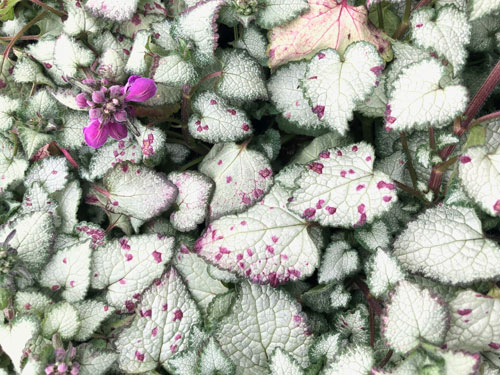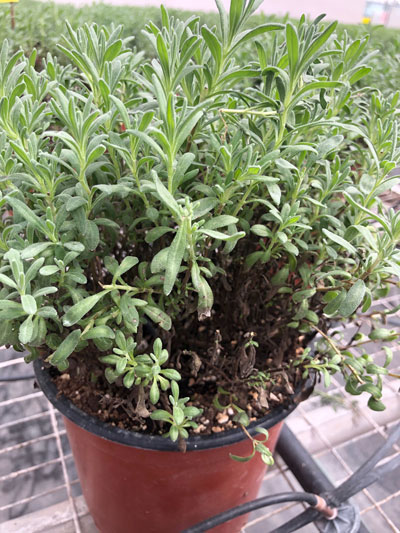4/1/2023
From the Plant Factory to the Disease Factory
Paul Pilon

With the mass production of plants inside greenhouses, I often refer to greenhouses as plant factories. In fact when I think about it, greenhouses are potentially better disease factories than plant factories. I’ll explain in more detail soon, but when you think about it, diseases have everything they need to thrive in greenhouse settings.
But, first, this takes me back to my days in Plant Pathology 101 when I first learned about the disease triangle. In short, the disease triangle demonstrates that diseases will only occur when interactions between all three corners or sides of the triangle (a susceptible host, a pathogen and a conducive environment) are present simultaneously. When only two of the three factors are present, a disease can’t occur. For example, If there’s a susceptible host plant and a pathogen present, but the proper environmental conditions are absent, a disease will not develop.
Contributing factors
• Contaminated or infected plant materials can easily be brought in from outside sources
• Temperatures are favorable for many pathogens
• Plants are often grown at high plant densities (close to one another)
• Air circulation and ventilation is often inadequate
• The humidity levels tend to be high inside greenhouse structures
• Condensation may develop on the plants or may fall on the crops when it develops on the ceiling
• Splashing water from irrigation and workers working in and around the crops can spread diseases from one plant to another
• Plant foliage often remains wet after overhead irrigation
• Plant stresses from various things such as heat, drought, overly wet growing conditions and high fertility levels can lead to diseases
With these contributing factors, I think you can see why I refer to greenhouses as plant disease factories. Most diseases thrive under the same growing conditions we provide to the crops, but when optimal conditions line up, watch out, as greenhouses can be ideal incubators for pathogens.
Not to be disrespectful to anyone, but I’ve also been known to say, “Diseases develop because of poor cultural practices.” Many of the contributing factors are out of our hands and how we often grow plants inside greenhouses leads to pathogen development and infections. Let me demonstrate what I’m referring to here.
 Pictured: Many diseases develop following several hours of leaf wetness. Certain diseases, such as downy mildew, can develop overnight like the downy mildew symptoms on this lamium.
Pictured: Many diseases develop following several hours of leaf wetness. Certain diseases, such as downy mildew, can develop overnight like the downy mildew symptoms on this lamium.
To reach a certain sales goal or to turn a profit, it’s often necessary to grow plants closer together than what’s ideal from a disease management perspective. When this occurs, it’s common for the micro-environment at or under the plant canopy to become ideal for diseases to prosper. There will be less air movement, higher humidity levels and it takes longer for the foliage to dry following overhead irrigation.
Speaking of overhead irrigation, it’s one of the biggest culprits on why diseases can become so prevalent inside structures. Most diseases require several hours (as few as three to six hours) of free moisture on plant surfaces to infect plants.
Although several growers do have state-of-the-art facilities with sophisticated environmental control systems, many growers produce perennials in facilities with inadequate ventilation systems or without the ability to automatically monitor and manage the humidity levels inside the structures.
Putting the disease factory on strike
The good news is there are several things growers can do to change the conditions suitable for pathogens and greatly reduce disease outbreaks from occurring.
• The one strategy I find the most effective at reducing the occurrence of diseases is to manage the humidity levels. This is done using humidity purge programs built inside most automated environmental control systems. Maintaining the relative humidity below 75% throughout the day and night will greatly decrease disease development. Managing the humidity is significantly more challenging when environmental control systems aren’t in place.
• The second most effective strategy I use involves reducing free moisture on plant surfaces. Constantly think about how extended periods of leaf wetness can also influence disease development. Plants really susceptible to foliar diseases could be put on drip irrigation or watered using subirrigation—both methods of irrigating crops will keep the foliage completely dry. Always water when the conditions allow the foliage to dry down quickly. Avoid watering on cloudy days or in the late afternoon when the leaves will remain wet for several hours.
• When possible, take steps to increase air circulation at crop level. Many greenhouses have horizontal air flow (HAF) fans, but may not have the proper quantity or placement to optimize air circulation within the structures.
• Many crops can be grown successfully at pot-to-pot configurations or with tight spacing, but when possible, consider giving plants highly susceptible to diseases a little more room to allow air to better move between the plants.
 • As they say, “An ounce of prevention is worth a pound of cure.” The plants we’re growing are a great investment that we rely on to bring in income when they’re sold. Applying fungicides preventatively is still a great strategy to protect this investment. All fungicides work best when they’re applied either before diseases are present or upon very early detection of them. Waiting for diseases to wreak havoc on crops before applying fungicides is too late and shouldn’t be how diseases are managed. Consider wide-scale broad spectrum preventative fungicide applications on a regular basis; perhaps every three to four weeks when no diseases are present, but tightening the application interval to every one to two weeks when diseases are observed or when the conditions are suitable for their development. At the very least, consider preventative programs on certain crops that have a history of getting diseases at your facility.
• As they say, “An ounce of prevention is worth a pound of cure.” The plants we’re growing are a great investment that we rely on to bring in income when they’re sold. Applying fungicides preventatively is still a great strategy to protect this investment. All fungicides work best when they’re applied either before diseases are present or upon very early detection of them. Waiting for diseases to wreak havoc on crops before applying fungicides is too late and shouldn’t be how diseases are managed. Consider wide-scale broad spectrum preventative fungicide applications on a regular basis; perhaps every three to four weeks when no diseases are present, but tightening the application interval to every one to two weeks when diseases are observed or when the conditions are suitable for their development. At the very least, consider preventative programs on certain crops that have a history of getting diseases at your facility.
Pictured: Here’s a lavender that was being grown pot-to-pot. This resulted in little air movement at the base of the plant, long dry times from overhead irrigation, and ultimately, the loss of lower leaves, which leads to a Botrytis infection and further lower leaf loss.
Growers are challenged with not only managing the incredible plant factories, but also with managing the unwanted disease factories that occur within our facilities. Although diseases frequently occur, it doesn’t have to be inevitable that they will occur. There are many cultural and management practices, as well as preventative programs, that can be implemented to keep diseases at bay. Let’s slow down production of the disease factory while maximizing the output of the plant factory. GT
Paul Pilon is editor-at-large of the Perennial Pulse e-newsletter and Director of Growing at Opel Growers in Hudsonville, Michigan. He can be reached at paul@opelgrowers.com.